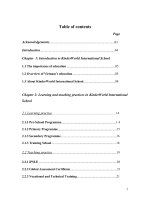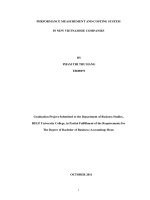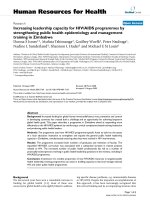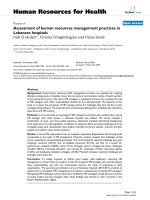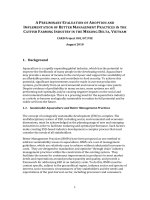Non financial performance measurement and management practices in manufacturing firms a comparative international analysis by marc j epstein
Bạn đang xem bản rút gọn của tài liệu. Xem và tải ngay bản đầy đủ của tài liệu tại đây (1.76 MB, 365 trang )
NON-FINANCIAL PERFORMANCE
MEASUREMENT AND
MANAGEMENT PRACTICES
IN MANUFACTURING FIRMS:
A COMPARATIVE
INTERNATIONAL ANALYSIS
STUDIES IN MANAGERIAL AND
FINANCIAL ACCOUNTING
Series Editor:
Volume 1:
Volume 2:
Volume 3:
Volume 4:
Volume 5:
Volume 6:
Volume 7:
Volume 8:
Volume 9:
Volume 10:
Volume 11:
Volume 12:
Volume 13:
Volume 14:
Marc J. Epstein
Setting the Standard for the New Auditors Report: An Analysis
of Attempts to Influence the Auditing Standards Board
The Shareholders Use of Corporate Annual Reports
Applications of Fuzzy Logic and the Theory of Evidence
to Accounting
The Usefulness of Corporate Annual Reports to
Shareholders in Australia, New Zealand, and the United States:
An International Comparison
A Power Control Exchange Framework of Accounting
Applications to Management Control Systems
Throughout Modeling: Financial Information Used by
Decision Makers
Applications of Fuzzy Sets and the Theory of Evidence
to Accounting II
Corporate Governance, Accountability, and Pressures to
Perform: An International Study
The January Effect and Other Seasonal Anomalies: A Common
Theoretical Framework
Organizational Change and Development in Management
Control Systems: Process Innovation for Internal Auditing
and Management Accounting
US Individual Federal Income Taxation: Historical,
Contemporary and Prospective Policy Issues
Performance Measurement and Management Control:
A Compendium of Research
Information Asymmetry: A Unifying Concept for Financial
and Managerial Accounting Theories
Performance Measurement and Management Control:
Superior Organization Performance
Volume 15: A Comparative Study of Professional Accountants’ Judgements
Volume 16: Performance Measurement and Management Control:
Improving Organizations and Society
STUDIES IN MANAGERIAL AND FINANCIAL
ACCOUNTING VOLUME 17
NON-FINANCIAL
PERFORMANCE
MEASUREMENT AND
MANAGEMENT PRACTICES
IN MANUFACTURING FIRMS:
A COMPARATIVE
INTERNATIONAL ANALYSIS
EDITED BY
AHMED B. ABDEL-MAKSOUD
University of Sharjah, United Arab Emirates
MAGDY G. ABDEL-KADER
Brunel University, UK
Amsterdam – Boston – Heidelberg – London – New York – Oxford
Paris – San Diego – San Francisco – Singapore – Sydney – Tokyo
JAI Press is an imprint of Elsevier
JAI Press is an imprint of Elsevier
Linacre House, Jordan Hill, Oxford OX2 8DP, UK
Radarweg 29, PO Box 211, 1000 AE Amsterdam, The Netherlands
525 B Street, Suite 1900, San Diego, CA 92101-4495, USA
First edition 2007
Copyright r 2007 Elsevier Ltd. All rights reserved
No part of this publication may be reproduced, stored in a retrieval system
or transmitted in any form or by any means electronic, mechanical, photocopying,
recording or otherwise without the prior written permission of the publisher
Permissions may be sought directly from Elsevier’s Science & Technology Rights
Department in Oxford, UK: phone (+44) (0) 1865 843830; fax (+44) (0) 1865 853333;
email: Alternatively you can submit your request online by
visiting the Elsevier web site at and selecting
Obtaining permission to use Elsevier material
Notice
No responsibility is assumed by the publisher for any injury and/or damage to persons
or property as a matter of products liability, negligence or otherwise, or from any use
or operation of any methods, products, instructions or ideas contained in the material
herein. Because of rapid advances in the medical sciences, in particular, independent
verification of diagnoses and drug dosages should be made
British Library Cataloguing in Publication Data
A catalogue record for this book is available from the British Library
ISBN: 978-0-7623-1403-4
ISSN: 1479-3512 (Series)
For information on all JAI Press publications
visit our website at books.elsevier.com
Printed and bound in the United Kingdom
07 08 09 10 11 10 9 8 7 6 5 4 3 2 1
For their love, support and encouragement, to our y
parents,
wives, Rania & Magda
children, Kariem and Aaya Abdel-Maksoud & Mohamed Abdel-Kader
This page intentionally left blank
CONTENTS
xi
LIST OF CONTRIBUTORS
PREFACE
xiii
LIST OF ABBREVIATIONS
xvii
PART I: INTRODUCTION AND FRAMEWORK
CHAPTER 1 NON-FINANCIAL PERFORMANCE
MEASURES – AN OVERVIEW
Ahmed Abdel-Maksoud and Magdy Abdel-Kader
3
CHAPTER 2 PERFORMANCE MEASUREMENT
SYSTEMS AT OPERATIONAL LEVEL
Ahmed Abdel-Maksoud
13
CHAPTER 3 SHOP-FLOOR NON-FINANCIAL
PERFORMANCE MEASURES AND THE
CONTINGENT VARIABLES
Ahmed Abdel-Maksoud
35
PART II: DATA COLLECTION AND ANALYSIS
CHAPTER 4 METHODOLOGY AND HYPOTHESES
DEVELOPMENT
Ahmed Abdel-Maksoud
71
vii
viii
CONTENTS
CHAPTER 5 NON-FINANCIAL PERFORMANCE
MEASURES IN THE UK MANUFACTURING FIRMS
Ahmed Abdel-Maksoud
CHAPTER 6 NON-FINANCIAL PERFORMANCE
MEASURES IN THE ITALIAN MANUFACTURING
FIRMS
Ahmed Abdel-Maksoud, Fabrizio Cerbioni and
Federica Ricceri
CHAPTER 7 NON-FINANCIAL PERFORMANCE
MEASURES IN JAPANESE MANUFACTURING
FIRMS
Ahmed Abdel-Maksoud, Takayuki Asada and
Masaru Nakagawa
CHAPTER 8 NON-FINANCIAL PERFORMANCE
MEASURES IN CANADIAN MANUFACTURING
FIRMS
Ahmed Abdel-Maksoud and Raili Pollanen
99
127
147
165
PART III: INTERNATIONAL COMPARISON
CHAPTER 9 NON-FINANCIAL PERFORMANCE
MEASURES: A CROSS-COUNTRIES COMPARISON
Ahmed Abdel-Maksoud and Magdy Abdel-Kader
191
CHAPTER 10 THE DESIGN AND APPLICATION OF
SHOP FLOOR NON-FINANCIAL PERFORMANCE
MEASURES ‘SCORECARDS’
Ahmed Abdel-Maksoud
229
Contents
ix
PART IV: FURTHER DEVELOPMENTS AND
CONCLUSIONS
CHAPTER 11 ADVANCED MANAGEMENT ACCOUNTING
PRACTICES AND COMPETITION IN MANUFACTURING
FIRMS
SivaKumar Velayutham and Ahmed Abdel-Maksoud
253
CHAPTER 12 PERFORMANCE MEASUREMENT
AND ORGANISATIONAL CHANGE MANAGEMENT
Raili Pollanen and Bharat Maheshwari
273
CHAPTER 13 WHERE TO GO: AN INSTITUTIONAL
THEORY FRAMEWORK FOR THE ROLE OF
PERFORMANCE MEASUREMENT SYSTEMS IN
MANUFACTURING FIRMS
Mostafa K. Hassan
305
CHAPTER 14 SUMMARY AND CONCLUSIONS
Ahmed Abdel-Maksoud
327
This page intentionally left blank
LIST OF CONTRIBUTORS
Magdy Abdel-Kader
Brunel Business School, Brunel
University, Uxbridge, Middlesex, UK
Ahmed Abdel-Maksoud
College of Business Administration,
University of Sharjah, Sharjah,
United Arab Emirates
Takayuki Asada
Graduate School of Economics,
Osaka University, Toyonaka City,
Osaka, Japan
Fabrizio Cerbioni
Department of Economic Sciences
(Marco Fanno), University of
Padova, Italy
Mostafa K. Hassan
Department of Accounting, College
of Business Administration,
University of Sharjah, Sharjah,
United Arab Emirates
Bharat Maheshwari
Sprott School of Business, Carleton
University, Ottawa, ON, Canada
Masaru Nakagawa
Faculty of Commerce, Doshisha
University, Kamigyo, Kyoto, Japan
Raili Pollanen
Sprott School of Business, Carleton
University, Ottawa, ON, Canada
Federica Ricceri
Department of Economic Sciences
(Marco Fanno), University of
Padova, Italy
SivaKumar Velayutham
College of Business Administration,
University of Sharjah, Sharjah,
United Arab Emirates
xi
This page intentionally left blank
PREFACE
Performance measurement is a key part of any organisational infrastructure
and an integral part of all management processes. Commentators advocate
that performance needs to be assessed to determine the adequacy of the
strategies for achieving organisations’ objectives, to revise and communicate
strategies, and to develop tactical objectives. It is argued that performance
measurement process should begin with strategy establishment and
determining how strategic objectives can be related to the products and
services that customer’s need. Organisations’ strategies and objectives will
be achieved through all management levels in the organisation – from the
top management level down to the shop-floor level. Everyone in the
organisation should understand the organisation’s strategy, be motivated to
contribute to its achievement, align his/her day-to-day activities to
accomplish strategic objectives, and find new and innovative opportunities
to contribute to achieve the organisation’s objectives.
Performance evaluation could be based on financial and/or non-financial
measures, and previous literature shows that performance evaluation of
each level of management is different. It is argued that senior managers are
well trained and adapted with financial measures and that the use of
financial measures at middle and top management levels is normally linked
to compensation. Contrarily, shop-floor staff – who perform the day-to-day
activities – are preferred to be evaluated using non-financial performance
measures.
Leading manufacturers worldwide have been found to focus on certain
broad categories of performance measures. These categories formed the
framework that guided this book and, given the importance of the role
played by shop-floor staff, operational performance is central to this book.
Thus, the focus of this book is confined only to the shop-floor non-financial
performance measures (SFNFPMs) in each of the following five evaluation
categories: product quality, customer satisfaction, on-time delivery,
employee morale, and efficiency and utilisation.
The book presents a cross-countries comparative study that provides a
framework for exploring the relationships between the use of non-financial
performance measures of the above five categories at the shop-floor level of
xiii
xiv
PREFACE
manufacturing firms across four different countries (UK, Italy, Japan, and
Canada) and a range of contingent factors incorporating technological,
managerial, organisational, and environmental factors. The study aims to
achieve three main objectives. First, to explore the contemporary
characteristics of the specified technological, managerial, organisational,
and environmental factors and the use of SFNFPMs in manufacturing firms
in the four countries surveyed. Second, to provide an understanding of the
relationships between the use and importance of SFNFPMs and the levels of
deployment/extent of importance of the contingent variables. Third, to
design shop-floor non-financial performance measurement scorecards in
manufacturing firms in the surveyed countries.
The proposed ‘scorecards’ are logical, and mathematically proven, causeand-effect models aiming at providing a better understanding of the use of
SFNFPMs in manufacturing firms. The proposed scorecards could be used
to help achieve integrity of the applied SFNFPMs and to identify any lack
of coordination/completeness. They, also, could be useful in making a shopfloor performance measurement system a ‘forward looking’ control system
thereby mitigating the problem of the historical nature of accounting data.
Achieving the above objectives can assist in gaining a better understanding of non-financial performance measures at shop-floor level in
manufacturing firms and in contributing to a more effective management of
manufacturing firms in the four countries. It, also, is expected to enhance
organisational knowledge about the use of non-financial measures in
performance measurement systems in manufacturing firms.
The inclusion of manufacturing firms from different countries was
purposive as to broaden the study across the borders of a single country.
The purpose was to cover manufacturing firms belonging to industrial
countries in various continents. However, the choice of the four industrial
countries included in this book was largely based on availability of funding
and access to data.
This book is organised into four parts. The first part comprises three
chapters and gives an introduction and framework to this research. Part II
(Chapters 4–8) gives details of the research method used and the results
related to each country under study. Part III (Chapters 9–10) provides
comparisons of the results across the four countries. Finally, Part IV
highlights some further developments and suggests avenues for future
research in this field. Three different areas are covered in Part IV. First, the
possible influence that managers’ perception of the importance of
competition could exert on their decisions to deploy certain contemporary
management accounting practices in manufacturing firms. Second, the role
Preface
xv
of performance measurement systems in the effective management of
organisational change – particularly discontinuous change. Third, the role
of a performance measurement system and performance measures in
organisational social context. Each of these three areas sheds light, and
invites further research studies, on different interpretational aspects of the
book theme.
Ahmed Abdel-Maksoud
Magdy Abdel-Kader
Editors
This page intentionally left blank
LIST OF ABBREVIATIONS
SFNFPM
AMT
FMS
CAD
CAM
CIM
CNC
CAE
AS/RS
AGVS
IMP
JIT
TQM
TPM
MRPI/II
ERP
OPT
CMAP
CPA
BP
SMA
ABT
TA
BSC
EVA
Shop-floor non-financial performance measure
Advanced manufacturing technology
Flexible manufacturing systems
Computer aided design
Computer aided manufacturing
Computer integrated manufacturing
Computer numerical control
Computer aided engineering
Automated storage and retrieval system
Automated guided vehicles systems
Innovative managerial practice
Just-in-time
Total quality management
Total preventive maintenance
Materials requirements/manufacturing resource planning
Enterprise requirement/resource planning
Optimised production technology
Contemporary management accounting practice
Customer profitability analysis
Benchmarking of performance
Strategic management accounting
Activity-based technique
Throughput accounting
Balanced scorecard
Economic value added
xvii
This page intentionally left blank
PART I:
INTRODUCTION AND
FRAMEWORK
This page intentionally left blank
CHAPTER 1
NON-FINANCIAL PERFORMANCE
MEASURES – AN OVERVIEW
Ahmed Abdel-Maksoud and Magdy Abdel-Kader
INTRODUCTION
To be successful in today’s worldwide competitive environment, companies
must be capable of manufacturing products of high quality at low cost and
providing a first-class customer service. Many companies have responded to
these competitive demands by implementing advanced manufacturing
technologies (AMTs), innovative managerial practices (IMPs), and emphasising quality, delivery, innovation, and flexibility to meet customer needs in
their corporate objectives (Banker, Potter, & Schoreder, 1993).
The adoption of AMTs and the redesign of work processes affected
organisations as these technologies rely on increased worker involvement in
the control of all phases of manufacturing and in the identification of
opportunities for process innovations and manufacturing performance
improvement (Kaplan, 1983; Banker et al., 1993). One approach to addressing
these changes is to revise the information captured for performance
measurement (Clark, 1989; Mather, 1989; Dixon, Nanni, & Vollmann,
1990; Kaplan & Norton, 1992).
In this chapter an introduction is given to the research problem,
objectives, and importance. The remaining of this chapter is organised in
four sections. The next section highlights the importance of the use of
Non-Financial Performance Measurement and Management Practices in Manufacturing Firms:
A Comparative International Analysis
Studies in Managerial and Financial Accounting, Volume 17, 3–12
Copyright r 2007 by Elsevier Ltd.
All rights of reproduction in any form reserved
ISSN: 1479-3512/doi:10.1016/S1479-3512(07)17001-5
3
4
AHMED ABDEL-MAKSOUD AND MAGDY ABDEL-KADER
non-financial performance measures in manufacturing firms. This is
followed by explaining the research problem and objectives. Fourth section
elaborates on the research importance and the final section gives an outline
of the book.
THE USE OF NON-FINANCIAL PERFORMANCE
MEASURES IN MANUFACTURING FIRMS
It has been argued that performance measurement systems in manufacturing
enterprises have remained static in spite of significant transformations in
management accounting approaches and production processes (Bhimani,
1993). The so-called traditional financial performance evaluation systems do
not provide feedback on the effectiveness of AMTs and IMPs. Moreover,
they are not sufficiently comprehensive to assess efforts to improve
competitiveness through AMTs and IMPs (Kaplan, 1983; Vollman, 1989;
Drucker, 1990; Johnson & Thomas, 1990; Hall, Johnson, & Turely, 1991;
Conti, 1993). Maskell (1989a) argues that
Commentators on manufacturing performance have strongly advocated the use of nonfinancial measures in managing production activities. Words such as customer service,
productivity, quality, flexibility, delivery time, competitive position, and production
process time permeate the literature on manufacturing performance measures. (p. 33)
The ‘day-to-day’ control of the manufacturing and distribution operations is
better handled with non-financial measures (Maskell, 1989a; Bhimani, 1993;
Bromwich & Bhimani, 1994; Otley, 1997). Bhimani (1993) states that British
manufacturers have begun to deploy novel manufacturing work methods
such as AMTs and IMPs. He argues that such changes require fundamental
alterations in performance measurement systems (Bhimani, 1993).
Survey results on UK manufacturers (Department of Trade & Industry
(DTI), 1989; CIMA, 1993; Drury, Braund, Obsorne, & Tayles, 1993) indicate
more emphasis within the surveyed companies on the use of non-financial
indicators, focusing particularly on quality issues and marketing activities
and a general awareness of different types of non-financial measures which
manufacturers could potentially use. Dimensions of non-financial performance such as customer satisfaction, employee efficiency, and quality levels
were considered important by all companies surveyed but not all of them had
developed satisfactory methods of dealing with non-financial measures
(CIMA, 1993).
Non-Financial Performance Measures – An Overview
5
Recent trends against the pervasive use of financial performance measures
are due to the emphasis in the academic business literature on such topics as
responsiveness, innovativeness, and quality. While traditional financial
performance measures do not capture all of the information manufacturers
required to consider, they are still of a considerable value. Commentators
implicitly assume that financial and non-financial performance measures can
be combined in complementary ways (CIMA, 1993). However, ‘‘there
appears not to be an optimal mix of specific financial and non-financial
indicators applicable to all manufacturers’’ (CIMA, 1993, Executive
Summary). The use of non-financial performance measures is seen by all
manufacturers as becoming more relevant (CIMA, 1993). A discussion of the
critique of financial measures and the use of non-financial measures is shown
in Chapter 2.
The application of AMTs/IMPs depends crucially on shop-floor workers
and this organisational level provides the focus of this research. In addition,
given the importance of non-financial performance measures in an AMT/
IMP environment, the focus, thus, is confined only to the non-financial
performance measures at shop-floor. Fig. 1 presents a hypothesised effect of
the deployment of IMPs/AMTs on both performance measurement systems
and on the shop-floor of an organisation.
Fig. 1 depicts the potential influence of the deployment of IMPs/AMTs on
performance measurement systems. On the one hand, it intensifies the
deployment of non-financial performance measures and, on the other, it
emphasises the increased role of shop-floor involvement (empowerment,
motivation, etc.).
Fig. 1.
The Effect of Deploying IMPs/AMTs on Performance Measurement and
Shop-Floor of an Organisation.
6
AHMED ABDEL-MAKSOUD AND MAGDY ABDEL-KADER
RESEARCH PROBLEM AND OBJECTIVES
Manufacturing firms striving for continuous improvements often deploy
AMTs/IMPs. While some firms excel because of their emphasis on AMTs/
IMPs, other firms that have implemented AMTs/IMPs do not appear to
have improved their performance. There is, however, little empirical
evidence that provides reasons for these mixed results (Powell, 1995). Some
researchers (see, for example, Kaplan, 1983; Johnson & Kaplan, 1987;
Banker et al., 1993) argue that the poor performance of many new
manufacturing initiatives is due, in part, to continued reliance on management accounting systems that fail to provide appropriate goals, performance
measures, or reward systems.
It is argued that traditional accounting measurements and control systems
are not appropriate in such a manufacturing environment (Drury, 1990).
Efficiency measures, for example, in traditional accounting measurements
can lead managers to increase batch sizes that increase inventory levels and
lead times while decreasing customer responsiveness. This is considered a
drawback in the development of AMTs/IMPs. Traditional performance
measurement systems also fail to report key variables such as quality,
reliability, lead time, flexibility, and customer satisfaction (Drury, 1990).
They may also have a delayed feedback in reporting while just-in-time (JIT)
requires real time information (Drury, 1990).
Effective implementation of AMTs/IMPs requires major changes in
organisational infrastructure. For instance, Wruck and Jensen (1994) suggest
that an effective implementation of total quality management (TQM)
requires major changes in systems of allocating decision rights, performance
measurement systems, and reward and punishment systems.
More research is needed on how the design of management accounting
systems interacts with manufacturing techniques to affect performance
(Ittner & Larcker, 1995), and commentators recommend that the nature of
manufacturing performance measures appropriate for different elements of
AMTs/IMPs are a useful area for further research (Kaplan, 1993; Kaplan &
Norton, 1992, 1996; Ittner & Larcker, 1995; Chenhall & Langfield-Smith,
1998a, 1998b; Neely & Adams, 2000; Kennerley & Neely, 2003).
The development of key performance measures may require companies to
look at the external environment (Otley, 1997; Ittner, Larcker, & Randall,
2003). It has been suggested (Drucker, 1990; CIMA, 1993; Bhimani, 1993,
1994; Otley, 1997) that elements such as the nature of competition and the
extent of AMTs/IMPs and structural innovations such as team-based work
groups are important in understanding the type of performance measures
